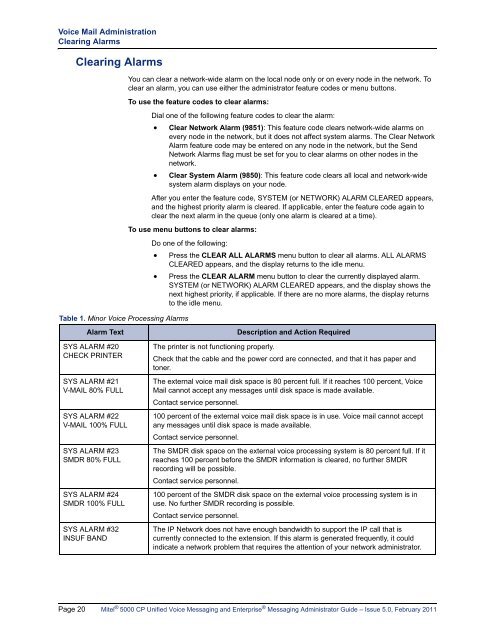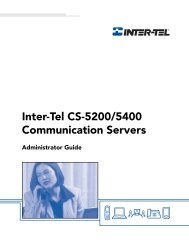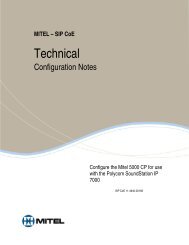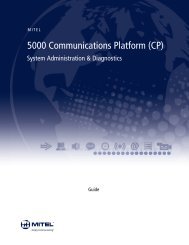Mitel 5000 CP v5.0 Voice Mail Administrator Guide.pdf
Mitel 5000 CP v5.0 Voice Mail Administrator Guide.pdf
Mitel 5000 CP v5.0 Voice Mail Administrator Guide.pdf
Create successful ePaper yourself
Turn your PDF publications into a flip-book with our unique Google optimized e-Paper software.
<strong>Voice</strong> <strong>Mail</strong> Administration<br />
Clearing Alarms<br />
Clearing Alarms<br />
Table 1. Minor <strong>Voice</strong> Processing Alarms<br />
You can clear a network-wide alarm on the local node only or on every node in the network. To<br />
clear an alarm, you can use either the administrator feature codes or menu buttons.<br />
To use the feature codes to clear alarms:<br />
Dial one of the following feature codes to clear the alarm:<br />
Clear Network Alarm (9851): This feature code clears network-wide alarms on<br />
every node in the network, but it does not affect system alarms. The Clear Network<br />
Alarm feature code may be entered on any node in the network, but the Send<br />
Network Alarms flag must be set for you to clear alarms on other nodes in the<br />
network.<br />
Clear System Alarm (9850): This feature code clears all local and network-wide<br />
system alarm displays on your node.<br />
After you enter the feature code, SYSTEM (or NETWORK) ALARM CLEARED appears,<br />
and the highest priority alarm is cleared. If applicable, enter the feature code again to<br />
clear the next alarm in the queue (only one alarm is cleared at a time).<br />
To use menu buttons to clear alarms:<br />
Do one of the following:<br />
Press the CLEAR ALL ALARMS menu button to clear all alarms. ALL ALARMS<br />
CLEARED appears, and the display returns to the idle menu.<br />
Press the CLEAR ALARM menu button to clear the currently displayed alarm.<br />
SYSTEM (or NETWORK) ALARM CLEARED appears, and the display shows the<br />
next highest priority, if applicable. If there are no more alarms, the display returns<br />
to the idle menu.<br />
Alarm Text<br />
SYS ALARM #20<br />
CHECK PRINTER<br />
SYS ALARM #21<br />
V-MAIL 80% FULL<br />
SYS ALARM #22<br />
V-MAIL 100% FULL<br />
SYS ALARM #23<br />
SMDR 80% FULL<br />
SYS ALARM #24<br />
SMDR 100% FULL<br />
SYS ALARM #32<br />
INSUF BAND<br />
Description and Action Required<br />
The printer is not functioning properly.<br />
Check that the cable and the power cord are connected, and that it has paper and<br />
toner.<br />
The external voice mail disk space is 80 percent full. If it reaches 100 percent, <strong>Voice</strong><br />
<strong>Mail</strong> cannot accept any messages until disk space is made available.<br />
Contact service personnel.<br />
100 percent of the external voice mail disk space is in use. <strong>Voice</strong> mail cannot accept<br />
any messages until disk space is made available.<br />
Contact service personnel.<br />
The SMDR disk space on the external voice processing system is 80 percent full. If it<br />
reaches 100 percent before the SMDR information is cleared, no further SMDR<br />
recording will be possible.<br />
Contact service personnel.<br />
100 percent of the SMDR disk space on the external voice processing system is in<br />
use. No further SMDR recording is possible.<br />
Contact service personnel.<br />
The IP Network does not have enough bandwidth to support the IP call that is<br />
currently connected to the extension. If this alarm is generated frequently, it could<br />
indicate a network problem that requires the attention of your network administrator.<br />
Page 20 <strong>Mitel</strong> ® <strong>5000</strong> <strong>CP</strong> Unified <strong>Voice</strong> Messaging and Enterprise ® Messaging <strong>Administrator</strong> <strong>Guide</strong> – Issue 5.0, February 2011









